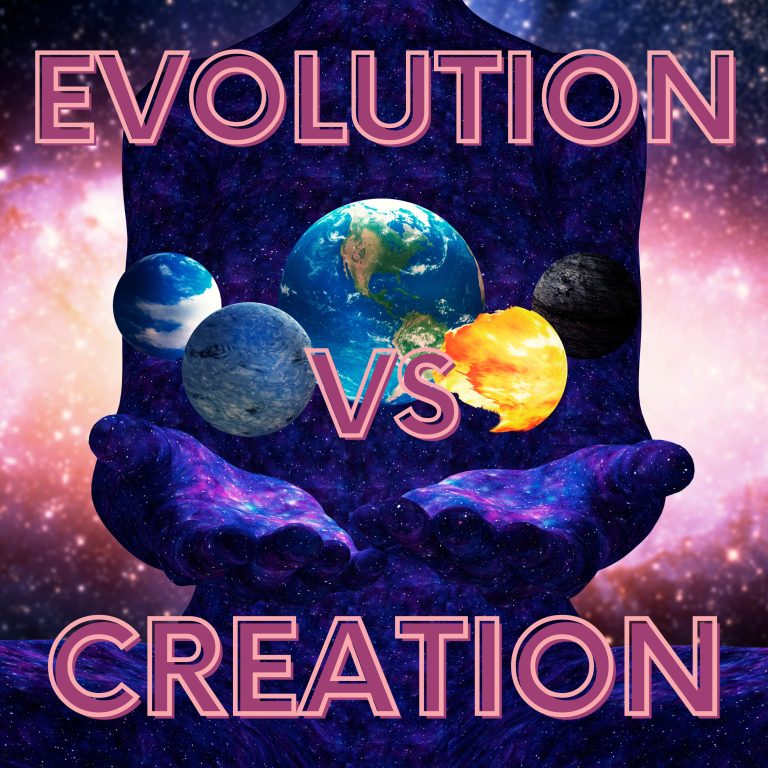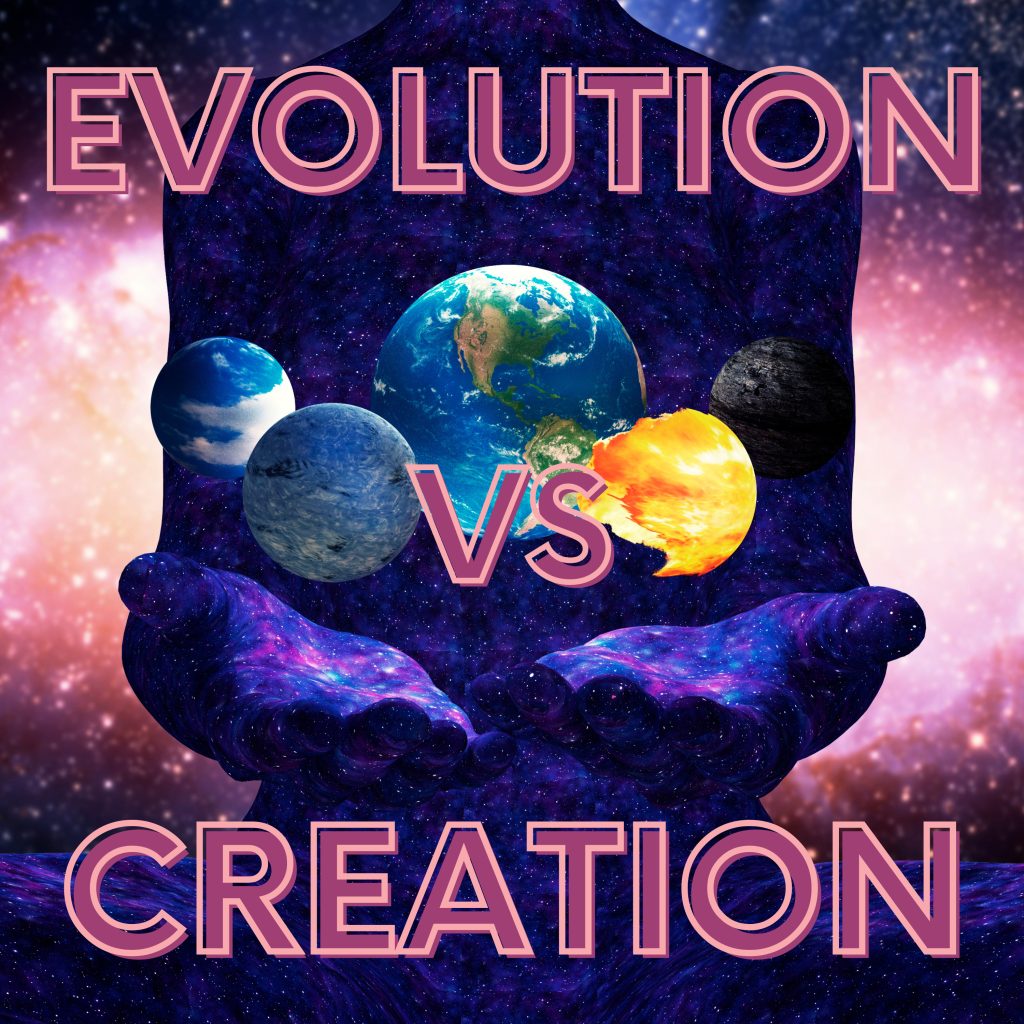
This show will get to the bottom of all those questions you need answers to. Each week we will cover a topic that has been left out in the public square unattended and covered with questions from the “official story” You will be able to determine on this show if the topic has been deemed a “Conspiracy” or a “Conspiracy Theory”.
Creation is the belief in God's holy word that the world as we know was created in 6 days. When we accept God’s Word as it’s written, we have a surefire starting point for reasoning about the world—including its difficult questions.
If you believe in evolution you have to believe in the scientific impossibility that nothing created something.
The theory of evolution claims that all the amazing complexity we see throughout creation comes about through undirected processes by means of random mutation and natural selection. Supposedly, if a mutation (”copying error”) occurs in the genes, and happens to give the creature some benefit, then this benefit is passed on to offspring through the process of natural selection. if this is truly possible we shouldn't have any problem seeing plenty of evidence of this taking place.
In this episode, we cover many topics such as:
Microevolution VS. Macroevolution
Radiometric Dating
Who has the most evidence: Creationists or evolutionists
Old Earth vs. New Earth
Carbon Dating
and much much more.
More resources found here –
https://answersingenesis.org/

Collins.com
Evolution is a process of gradual change that takes place over many generations, during which species of animals, plants, or insects slowly change some of their physical characteristics.
britannica.com
evolution, theory in biology postulating that the various types of plants, animals, and other living things on Earth have their origin in other preexisting types and that the distinguishable differences are due to modifications in successive generations. The theory of evolution is one of the fundamental keystones of modern biological theory.
Do any of these statements sound familiar?

Earth is millions of years old. Adam wasn’t a real person. Humans evolved from apelike ancestors. Genesis doesn’t matter—just the New Testament. If you believe in creation, then you don’t believe in science.
Creation is the belief in God’s holy word that the world as we know was created in 6 days.
When we accept God’s Word as it’s written, we have a surefire starting point for reasoning about the world—including its difficult questions.
If you believe in evolution you have to believe in the scientific impossibility that nothing created something.
The theory of evolution claims that all the amazing complexity we see throughout creation comes about through undirected processes by means of random mutation and natural selection. Supposedly, if a mutation (“copying error”) occurs in the genes, and happens to give the creature some benefit, then this benefit is passed on to offspring through the process of natural selection. if this is truly possible we shouldn’t have any problem seeing plenty of evidence of this taking place.
Microevolution VS. Macroevolution
First, it is important to realize that species do change over time by adaptation. Look at the variety within dogs from the tiny Chihuahua to the huge great dane. These small-scale variations within a kind are sometimes called microevolution. But note that nothing new actually comes into being “Evolves” in microevolution. Though these dogs have incredible differences, they are still dogs. There are tremendous variations among humans. Think of all the different features from Asian to African to Aboriginal to Caucasian. But we are all within the same species, Homo sapiens.
Darwin’s theory of evolution, however, is based on the concept of macroevolution. This is the inference that the small changes seen in adaptation can accumulate and lead to large changes over long periods of time. In macroevolution, one kind of creature such as a reptile becomes another kind of creature such as a bird, requiring the creation of entirely new features and body types. This would be a bit like observing a car going from 0 to 60 mph in 60 seconds and inferring that it can then go 6,000 mph in 100 minutes – and become an airplane in the process.
That’s an illogical assumption, and it puts a tremendous responsibility on mutations to accidentally create complex new body parts, and on natural selection to recognize the benefit these new parts will eventually convey and make sure the creatures with those new parts survive.
The essence of Darwinism lies in a single phrase: natural selection is the creative force of evolutionary change. No one denies that selection will play a negative role in eliminating the unfit. Darwinian theories require that it create the fit as well.
Radiometric Dating
Does radiometric dating show that rocks are millions of years old? NO! This dating method requires assumptions about the content of the original rock and the decay rate in the past. Since the Bible is clear about the earth’s age of thousands of years the popular assumptions are wrong. God took great care to include the necessary chronological details of the universe’s creation in six literal days, as well as the unbroken genealogies of mankind from Adam to Jesus. So we have absolutely no doubt that the earth is only around six thousand years old.
Contrary to scripture, many geologists claim that radiometric clocks show rock to be millions of years old. However, to read any clock accurately we must know where the clock was set at the beginning. It’s like making sure the hourglass clock is set with all the sand in the top bowl at the beginning. However, no geologists were present when the earth and its many rock layers were formed, so they can not know where the radiometric clocks were set at the beginning.
Also, we have to be sure that the clock has ticked at the same rate from the beginning until now. No geologists have been observing the radiometric clocks for millions of years to check that the rate of radioactive decay has always been the same as the rate today. To the contrary, we now have impeccable evidence that radioactive decay rates were greatly sped up at some point during the past, for example, during the global flood in Genesis.
God is beyond time, which he created. he has told us when he created everything and how old the universe is. So we finite humans should fearlessly embrace his testimony of a young earth, recorded in his word.
Who has the most evidence: Creationists or evolutionists
In this ongoing war between creation and evolution, Christians are always looking for the strongest evidence for creation, wanting to have “our” facts/evidence to counter theirs. However, it is not a matter of their evidence vs. ours, All evidence is actually interpreted, and all scientists actually have the same observations and the same data available to them. Creationists and evolutionists, Christians and non-Christians, all have the same evidence and the same facts. Think about it we all have the same earth, the same follis layers, the same animals and plants, the same stars- the facts are all the same.
The difference is in the way we all interpret the facts. And why do we interpret facts differently? It is because we start with different presuppositions or starting points. These then become the basis for other conclusions. All reasoning is based on presuppositions. This becomes especially relevant when dealing with past events.
So it’s not a battle over sorting out different evidence. It’s really a battle over the same evidence. The difference is whose interpretation are you going to trust? Will you start with an all-knowing God, who has always been there, created everything, and cannot lie…or would you dare start with fallible ideas about the past from sinful men who were not there?
The discussion of Creation vs evolution reallys comes down to the belief in an old earth a new earth
**Genesis 1:1:**
In the beginning, God created the heavens and the earth.
**Genesis 1:2:**
Now the earth was formless and empty, darkness was over the surface of the deep, and the Spirit of God was hovering over the waters.
These verses are the opening lines of the biblical creation narrative, describing the initial act of creation by God and the state of the Earth before God’s creative work begins.
“The two Views”
**Old Earth View:**
– **Age of the Earth:** In the Old Earth view, the Earth is estimated to be about 4.5 billion years old, based on radiometric dating of rocks and minerals, the study of Earth’s geological processes, and evidence from astronomy.
– **Universe’s Age:** This perspective aligns with the scientific consensus on the age of the universe, which is estimated to be approximately 13.8 billion years old based on observations of cosmic microwave background radiation and the expansion of the universe.
– **Evolutionary Biology:** Old Earth proponents generally accept the theory of evolution as the best explanation for the diversity of life on Earth. They believe that species have evolved over millions of years through natural selection and genetic processes.
– **Secular Perspective:** The Old Earth view is often associated with secular scientific explanations of the Earth’s history and the development of life, without the need for supernatural or religious intervention.
-** Evolution only fits into the Old earth View
**Young Earth View:**
– **Age of the Earth:** In the Young Earth view, the Earth is believed to be relatively young, typically around 6,000 to 10,000 years old. This age is calculated based on a literal interpretation of the genealogies and events described in religious texts, such as the Bible.
– **Universe’s Age:** Young Earth proponents also argue for a young universe, typically less than 10,000 years old, based on similar religious texts.
– **Creationism:** Young Earth creationists reject the theory of evolution and instead believe in special creation, which posits that God or a supernatural force directly created each species in its present form.
– **Biblical Literalism:** This view emphasizes a strict, literal interpretation of religious texts, particularly the Book of Genesis, as a historical and scientific account of the Earth’s origins.
– **Religious Perspective:** Young Earth creationism is often associated with certain religious beliefs, particularly among conservative Christians, who interpret their religious texts as providing a detailed chronological account of the Earth’s history.
The estimation that the Earth is approximately 4.5 billion years old is based on Radiometric Dating
1. **Radiometric Dating:** Radiometric dating is a fundamental method used to determine the age of rocks and minerals. The most widely used radiometric dating method for dating the Earth is uranium-lead dating. This technique involves measuring the ratio of isotopes of uranium and lead in certain minerals, such as zircon crystals, found in Earth’s crust. By measuring the radioactive decay of uranium isotopes into lead isotopes, scientists can calculate the age of the minerals and, by extension, the age of the Earth.
Carbon Dating is Different than Radiometric
Carbon dating, also known as radiocarbon dating, is a specific type of radiometric dating. Radiometric dating is a broader category of dating methods that use the radioactive decay of isotopes to determine the age of geological, archaeological, or paleontological materials. Here’s the key difference between carbon dating and radiometric dating:
1. **Carbon Dating (Radiocarbon Dating):** Carbon dating specifically focuses on the decay of Carbon-14 (C-14) isotopes. It is used to date organic materials that were once part of a living organism, such as wood, bone, and charcoal. Carbon dating is effective for dating materials up to approximately 50,000 years old.
2. **Radiometric Dating (General):** Radiometric dating encompasses a wide range of methods, each of which targets different radioactive isotopes with varying half-lives. These methods are used to date a broader spectrum of materials, including rocks, minerals, and fossils. Some common radiometric dating methods include uranium-lead dating, potassium-argon dating, and rubidium-strontium dating, among others. Radiometric dating can be used to determine the ages of materials ranging from thousands to billions of years old, depending on the specific method and isotopes involved.
In summary, carbon dating is a specific subset of radiometric dating that focuses on the decay of Carbon-14 isotopes and is primarily used for dating relatively young organic materials. Radiometric dating, on the other hand, includes a variety of methods that utilize the decay of different radioactive isotopes to date a wide range of geological and archaeological specimens over various timescales.
What is Carbon Dating?
Carbon dating, formally known as radiocarbon dating, is a widely used scientific method for determining the age of an object containing organic material by measuring the amount of Carbon-14 (C-14) it contains. This dating technique is particularly valuable for dating archaeological and geological specimens up to around 50,000 years old. Here’s how carbon dating works:
1. **Carbon Isotopes:** Carbon exists in three isotopic forms, with C-12 and C-13 being stable and C-14 being radioactive. C-14 is produced naturally in the Earth’s upper atmosphere when cosmic rays interact with nitrogen atoms. This process results in the formation of radioactive C-14 isotopes.
2. **C-14 Uptake:** Living organisms, including plants, animals, and humans, constantly absorb carbon from their environment, including a small proportion of C-14. As long as an organism is alive, it maintains a consistent ratio of C-14 to stable carbon isotopes.
3. **Death and Decay:** When an organism dies, it stops taking in carbon, including C-14. At this point, the radioactive C-14 atoms within its tissues begin to decay into nitrogen (N-14) at a known rate, called the half-life. The half-life of C-14 is approximately 5,730 years, which means that after this time, half of the C-14 originally present will have decayed.
4. **Measuring C-14:** Scientists can measure the remaining C-14 in a sample using specialized instruments like accelerator mass spectrometers. By comparing the ratio of C-14 to C-12 in the sample to the ratio in the atmosphere (which is relatively constant), they can determine how long it has been since the death of the organism.
5. **Calibration:** Radiocarbon dates are typically calibrated to account for variations in atmospheric C-14 levels over time. This calibration process uses known records, such as tree-ring sequences, to adjust the raw radiocarbon dates, providing a more accurate estimate of the calendar age of the sample.
Carbon dating is particularly useful for dating organic materials such as wood, bone, cloth, and charcoal found in archaeological sites, as well as for studying the age of ancient fossils and geological deposits. However, it has a limited dating range, typically up to around 50,000 years, because the amount of C-14 in a sample becomes too low for accurate dating beyond that point.
“Carbon Dating is proven to be innaccurate”
1. **Shroud of Turin:** The Shroud of Turin is a linen cloth that bears the image of a man with supposed crucifixion wounds. Radiocarbon dating conducted in 1988 dated the cloth to the 13th to 14th centuries. However, subsequent research and debates have arisen over the accuracy of the dating due to concerns about sample contamination and possible repairs to the shroud over the centuries.
2. **Mohenjo-Daro:** Mohenjo-Daro is an ancient Indus Valley civilization city. Some radiocarbon dating attempts on materials from the site have produced inconsistent results, possibly due to contamination or issues related to the local environment.
3. **Dinosaurs:** Radiocarbon dating is generally not used to date dinosaur fossils because they are typically considered to be much older than the dating range of carbon-14. However, in some cases, reports of radiocarbon dating results on dinosaur bones have been published, suggesting ages much younger than expected. These results are often met with skepticism by the scientific community, with concerns about contamination or analytical issues.
4. **Deep Ocean Waters:** Radiocarbon dating of deep-sea organisms can be challenging due to the presence of “old carbon” from dissolved carbonates in the deep ocean. This can result in marine samples appearing older than they are, especially if not properly corrected for the marine reservoir effect.
5. **Antler Combs:** In an archaeological context, radiocarbon dating of antler combs from Viking-era graves in Scandinavia led to discrepancies in dates. This was attributed to the fact that the antler material may have come from animals that had consumed older carbon sources or from combs that were made from antlers collected much earlier.
6. **Coal and Diamond Inclusions:** Carbon-14 has been detected in coal and diamonds, which are thought to be millions to billions of years old. Some creationist arguments have been based on this finding, suggesting that radiocarbon dating is fundamentally flawed. However, these cases are often explained by the presence of very low levels of modern carbon contamination.
Scientists stick to the Old earth due to the mental paradigm of “Old Earth”
With the given age of the dinosaurs being longer than 50,000 years how do they date them?
How Are dinosaurs Dated?
1. **Radiometric Dating:** Dinosaur bones themselves do not contain radioactive isotopes suitable for radiometric dating because bones are primarily composed of minerals that do not undergo radioactive decay. However, the sedimentary rocks in which dinosaur fossils are found often contain volcanic ash or minerals that can be dated using radiometric techniques.
– **Potassium-Argon (K-Ar) Dating:** This method is commonly used to date volcanic rocks associated with dinosaur fossils. It measures the decay of potassium-40 (K-40) isotopes into argon-40 (Ar-40) isotopes. By dating the volcanic layers above and below the fossils, scientists can estimate the age of the dinosaur remains.
– **Uranium-Series Dating:** Some fossils, like teeth or bones, can contain trace amounts of uranium. Uranium-series dating methods can be used to date these materials. The decay of uranium isotopes into thorium and protactinium provides a dating clock.
– **Luminescence Dating:** In some cases, sediment layers surrounding dinosaur fossils can be dated using luminescence dating methods, such as optically stimulated luminescence (OSL) or thermoluminescence (TL). These methods determine when minerals within the sediment were last exposed to light or heat.
2. **Stratigraphy:** Stratigraphy involves studying the layers of sedimentary rock in which fossils are found. By analyzing the sequence of rock layers and the fossils contained within them, scientists can develop a relative dating framework. This allows them to determine the relative ages of different dinosaur species and their positions in the geological record.
3. **Biostratigraphy:** Biostratigraphy is a specialized form of stratigraphy that relies on the presence of specific fossil species known as index fossils. By identifying these fossils within sedimentary layers, scientists can correlate rock layers from different locations and assign relative ages to the fossils they contain.
4. **Cross-Correlation:** When multiple dating methods are applied to a site containing dinosaur fossils, and the results are consistent with each other and with the geological context, scientists can establish a more robust estimate of the fossils’ age.
How are fossils Made?
The process of fossilization, where organic materials are gradually replaced by minerals, is extremely slow and can take a very long time. The time it takes for a fossil to form depends on various factors, including the type of organism, environmental conditions, and the specific mineralization process. Here’s a general idea of the timeframes involved in the fossilization process:
1. **Initial Burial:** When an organism dies, it needs to be quickly buried by sediments, such as mud or sand, to protect it from scavengers and decomposition. This initial burial can occur relatively quickly, usually within weeks to months after death.
2. **Decomposition:** Once buried, the soft tissues of the organism start to decay, and microbial activity begins. During this stage, bones, shells, or other hard parts of the organism may remain intact, but the organic material is gradually broken down. This stage can last from months to several years.
3. **Mineralization:** After decomposition, the mineralization process begins. Groundwater containing dissolved minerals (typically calcium carbonate or silica) percolates through the sediments and starts to replace the original organic materials with minerals. This process can be incredibly slow, taking thousands to millions of years.
4. **Completion of Fossilization:** The process of complete fossilization, where all organic materials have been replaced by minerals, can take anywhere from tens of thousands to millions of years, depending on the size and type of the organism and the specific geological conditions.
5. **Discovery and Exposure:** Even after fossilization is complete, a fossil may remain hidden in the Earth’s layers for extended periods. It often takes geological processes like erosion, uplift, and weathering to expose the fossil at the surface, where it can be discovered by paleontologists or fossil hunters.
It’s important to emphasize that fossilization is a rare event, and the vast majority of organisms that have ever lived did not become fossils. Only a tiny fraction of life on Earth becomes fossilized due to the specific conditions required for preservation.
The actual timeframes involved in fossilization can vary widely depending on the circumstances and geological history of the location where the fossil is found. Some fossils are relatively young, dating back a few thousand years, while others are millions or even billions of years old, such as certain stromatolite fossils. The age of a fossil is determined through radiometric dating methods and geological analysis.
“Gaps in the fossil record”
1. **Creation as a Singular Act:** From a biblical perspective, God created all life forms in a relatively short period, as described in Genesis. Each species was created “after its kind,” and these distinct kinds do not transition into one another over time.
2. **Absence of Transitional Forms:** Proponents of a biblical worldview argue that the lack of clear transitional forms in the fossil record aligns with the biblical account of separate creation events for different kinds of organisms. In this view, each kind was created distinct from the others, and there should be no expectation of finding transitional fossils between them.
3. **Stasis as Design:** Instead of viewing the stasis of species in the fossil record as evidence of evolutionary stalling, proponents of biblical creation see it as evidence of the design and stability of each created kind. Each kind was designed to be well-suited to its environment and has remained relatively unchanged since its initial creation.
4. **Rapid Formation of Fossils:** Some proponents argue that the rapid burial of organisms during catastrophic events, such as the global flood described in the Bible, could explain the sudden appearance of diverse life forms in the fossil record during the Cambrian Explosion. They suggest that the floodwaters and sediment deposition were responsible for preserving these organisms as fossils.
Is Genesis History?
“Is Genesis History?” is a documentary film released in 2017, directed by Thomas Purifoy Jr. In this film, it explores the topic of creationism and the historicity of the Book of Genesis from a scientific and biblical perspective. The documentary features interviews with scientists, theologians, and scholars who present arguments in favor of a literal interpretation of Genesis, particularly focusing on the creation account and the global flood described in the Bible. The film seeks to provide evidence and viewpoints that support a young-earth creationist perspective while challenging the conventional scientific theories of evolution and an old-earth timeline. It aims to spark a dialogue about the intersection of science and faith in understanding the origins of the Earth and the universe.
1. **Dr. Andrew Snelling (Geologist):**
– **Polystrate Fossils:** Dr. Snelling discusses the presence of polystrate fossils, which are fossils that extend through multiple layers of sedimentary rock. He argues that these fossils provide evidence of rapid deposition, as it would be highly unlikely for a tree, for example, to remain upright and gradually fossilize over millions of years.
2. **Dr. Kurt Wise (Paleontologist):**
– **Absence of Transitional Fossils:** Dr. Wise emphasizes the lack of transitional fossils in the fossil record, which are organisms that show intermediate stages of evolution between major groups. He argues that the absence of these fossils challenges the idea of gradual evolution and aligns with the concept of separate, specially created kinds.
3. **Dr. Steve Austin (Geologist):**
– **Grand Canyon Formation:** Dr. Austin examines the Grand Canyon and suggests that its formation can be explained by the rapid carving of the canyon through catastrophic processes, particularly the erosive power of a large-scale flood event. He points to features like sedimentary layers and the lack of significant erosion between layers as evidence of rapid formation.
4. **Dr. Marcus Ross (Paleontologist):**
– **Soft Tissue in Dinosaur Fossils:** Dr. Ross discusses the discovery of soft tissue remnants in some dinosaur fossils, such as preserved blood vessels and cells. He argues that the presence of such delicate structures challenges the conventional understanding of fossilization, which typically involves the replacement of organic material with minerals over long periods.
5. **Dr. Kevin Anderson (Microbiologist):**
– **Genetic Diversity and Mutation Rates:** Dr. Anderson examines genetic diversity among humans and suggests that it can be explained within a biblical framework of a relatively recent common ancestry. He points to mutation rates and genetic data as supportive of the idea that human genetic diversity has accumulated over a shorter time span than conventional evolutionary models propose.
These scientific arguments and evidence are presented in the film to support the idea of a young Earth and a global flood as described in the Book of Genesis. It’s important to note that these interpretations are not widely accepted within mainstream science, and there are ongoing debates and discussions within the scientific community regarding these topics.


